Adobe PHOTOSHOP ALBUM 2.0 User Manual
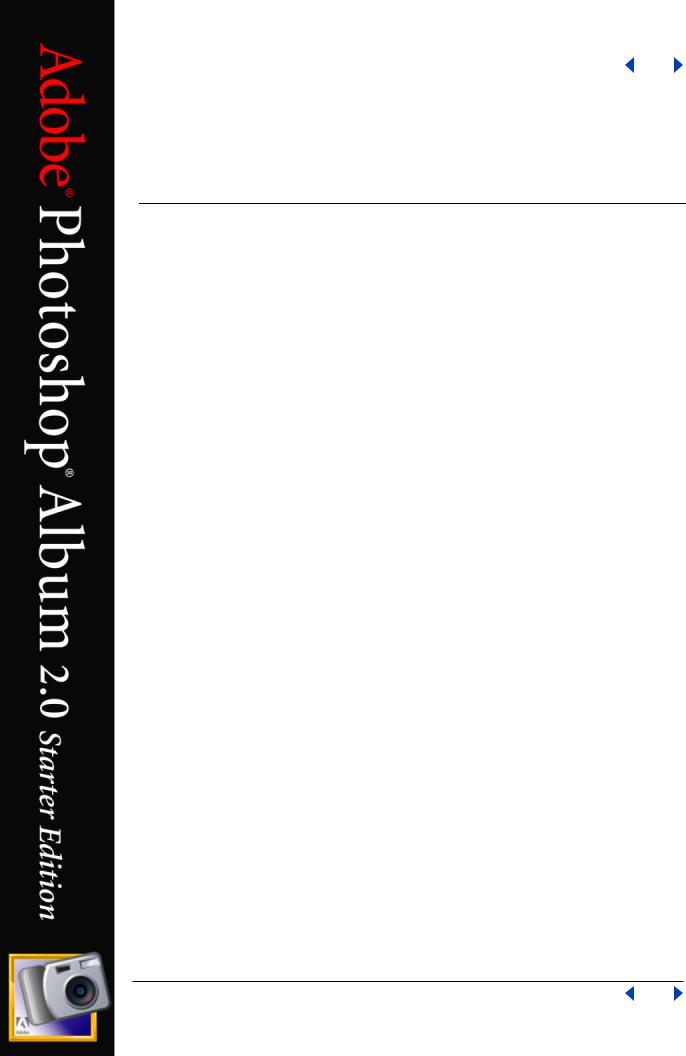
Adobe Photoshop Album Help |
|
UsingHelp |
|
|
|
Using Help | Contents | Index |
Back |
1 |
Using Help
About Help
Adobe Systems Incorporated provides complete documentation in an Adobe PDF-based help system. This help system includes information on all tools, commands, and features of an application. It is designed for easy on-screen navigation and can also be printed and used as a desktop reference. Additionally, it supports third-party screen-reader applications that run in a Windows environment.
Navigating in Help
Help opens in an Adobe Acrobat window with the Bookmarks pane open. (If the Bookmarks pane is not open, click the Bookmarks tab at the left edge of the window.)
At the top and bottom of each page is a navigation bar containing links to this page (Using Help), the table of contents (Contents), and the index (Index).
To move through pages sequentially, you can click the Next Page  and the Previous Page
and the Previous Page  arrows; click the navigation arrows at the bottom of the page; or click Back to return to the last page you viewed.
arrows; click the navigation arrows at the bottom of the page; or click Back to return to the last page you viewed.
You can navigate Help topics by using bookmarks, the table of contents, the index, or the Search (Acrobat 6) or Find (Acrobat 5) command.
To find a topic using bookmarks:
1In the Bookmarks pane, click the plus sign (+) (Windows) or the right-facing arrow (Mac OS) next to a bookmark topic to view its subtopics.
2Click the bookmark to go to that topic.
To find a topic using the table of contents:
1Click Contents in the navigation bar.
2On the Contents page, click a topic to go to that topic.
3To view a list of subtopics, click the plus sign (+) (Windows) or the right-facing arrow (Mac OS) next to the topic name in the Bookmarks pane.
To find a topic using the index:
1 Do one of the following:
•Click Index in the navigation bar, and then click a letter at the top of the page.
•Ιn the Bookmarks pane, expand the Index bookmark to view the letter subtopics; then click a letter.
2Locate the entry you want to view, and click the page number to go to that topic.
3To view other entries for the same topic, click Back to return to the same place in the index, and then click another page number.
Using Help | Contents | Index |
Back |
1 |

Adobe Photoshop Album Help |
|
UsingHelp |
|
|
|
Using Help | Contents | Index |
Back |
2 |
To find a topic using the Search command (Acrobat 6):
1Choose Edit > Search.
2Type a word or phrase in the text box and click Search. Acrobat searches the document and displays every occurrence of the word or phrase in the Results area of the Search PDF pane.
To find a topic using the Find command (Acrobat 5):
1Choose Edit > Find.
2Type a word or phrase in the text box and click Find. Acrobat searches the document, starting from the current page, and displays the first occurrence.
3To find the next occurrence, choose Edit > Find Again.
Printing Help
Although Help is optimized for on-screen viewing, you can print selected pages or the entire file.
To print Help:
Choose File > Print, or click the Print icon in the Acrobat toolbar.
Using Help | Contents | Index |
Back |
2 |
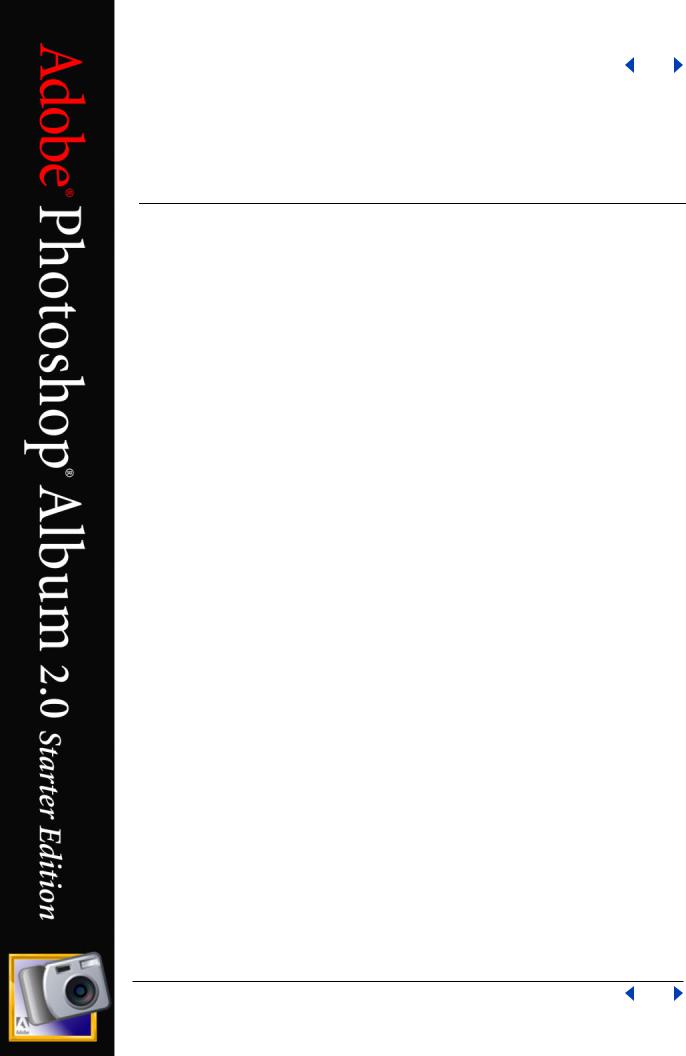
Adobe Photoshop Album Help |
|
Contents |
|
|
|
Using Help | Contents | Index |
Back |
3 |
Contents
Addendum: Getting Started with Adobe Photoshop Album 2.0 Starter Edition 4 Installing and Learning to Use Adobe Photoshop Album 12
Photoshop Album Basics 15
Getting Photos into Photoshop Album 25
Organizing Photos 42
Viewing and Finding Photos 79
Fixing Photos 98
Making Creations from Your Photos 119
Sharing, Printing, and Exporting Photos 144
Shortcuts 163
Legal Notices 166
Using Help | Contents | Index |
Back |
3 |
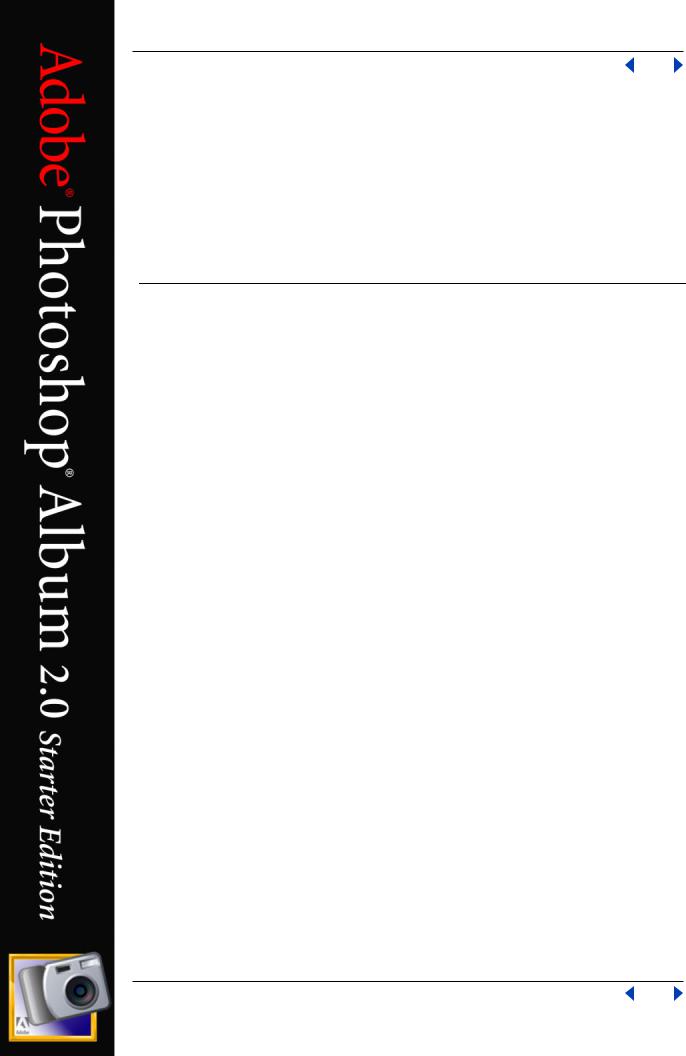
Adobe Photoshop Album Help Addendum: Getting Started with Adobe Photoshop Album 2.0
Using Help | Contents | Index |
Back |
4 |
Addendum: Getting Started with Adobe Photoshop Album 2.0 Starter Edition
About Photoshop Album 2.0 Starter Edition
Welcome to the Adobe® Photoshop® Album Starter Edition application, the fast and easy way to organize your lifetime of photos so that you can instantly find the ones you want and share your experiences with anyone, anywhere. Photoshop Album 2.0 Starter Edition offers many of the important features found in Photoshop Album 2.0.This addendum supplements the Photoshop Album 2.0 Help and will get you started using Photoshop Album 2.0 Starter Edition immediately. For detailed information on using the Photoshop Album 2.0 Starter Edition and on the additional features in Photoshop Album 2.0, see the main Photoshop Album 2.0 Help.
Installing Photoshop Album 2.0 Starter Edition
To install Photoshop Album 2.0 Starter Edition, launch the installer and follow the onscreen instructions.
If Photoshop Album 1.0 or Photoshop Album 1.0 Starter Edition is already installed on your computer, Photoshop Album 2.0 Starter Edition installs and automatically creates a copy of your existing catalog.The original catalog file remains unaltered so you can continue using it with Photoshop Album 1.0 or Photoshop Album 1.0 Starter Edition.
Photoshop Album 2.0 Starter Edition cannot be installed on a computer that already has Photoshop Album 2.0 installed.
Note: Photoshop Album 2.0 Starter Edition does not support certain Photoshop Album 1.0 and Photoshop Album 1.0 Starter Edition features such as creations; file formats other than BMP, JPEG, or TIFF; burning to CD or DVD; and the calendar view. Unsupported features will not show in the Photoshop Album 2.0 Starter Edition catalog. However, if you upgrade to Photoshop Album 2.0, all features unsupported in Photoshop Album 2.0 Starter Edition will be carried forward into the Photoshop Album 2.0 catalog.
Starting Photoshop Album 2.0 Starter Edition
The first time you start the Photoshop Album 2.0 Starter Edition application, you’ll be presented with the Adobe End User License Agreement window. Click Agree to continue using the application.
After closing the License Agreement, you’re prompted to register online. Use the Registration Wizard to register and use your copy of Photoshop Album 2.0 Starter Edition.
Using Help | Contents | Index |
Back |
4 |

Adobe Photoshop Album Help Addendum: Getting Started with Adobe Photoshop Album 2.0
Using Help | Contents | Index |
Back |
5 |
Using the Quick Guide
By default, the Quick Guide window opens when you first start Photoshop Album 2.0 Starter Edition.The Quick Guide is a convenient starting point for key tasks in Photoshop Album 2.0 Starter Edition. Select a task by clicking an icon or tab in the Quick Guide Overview window.You can open or close the Quick Guide at any time while you’re using Photoshop Album 2.0 Starter Edition.
To open or close the Quick Guide:
Choose Help > Quick Guide.
Getting photos into Photoshop Album Starter Edition
The first thing you’ll probably need to do is get photos into Photoshop Album 2.0 Starter Edition.You might already have photos on your computer, or you might need to get photos from your digital camera.
To get photos from your computer’s hard drive:
In the Photoshop Album 2.0 Starter Edition Quick Guide, click the Get Photos  in the Overview tab or the Get Photos tab, and then click Search Drive
in the Overview tab or the Get Photos tab, and then click Search Drive  . Follow the on-screen instructions to search for and import photos into Photoshop Album 2.0 Starter Edition.
. Follow the on-screen instructions to search for and import photos into Photoshop Album 2.0 Starter Edition.
To get photos from a digital camera or card reader:
1Make sure that your camera or card reader is connected properly and turned on.
2In the Photoshop Album 2.0 Starter Edition Quick Guide window, click the Get Photos
 in the Overview tab or the Get Photos tab, and then click Camera
in the Overview tab or the Get Photos tab, and then click Camera  . Follow the onscreen instructions to finish importing the photos into Photoshop Album 2.0 Starter Edition.
. Follow the onscreen instructions to finish importing the photos into Photoshop Album 2.0 Starter Edition.
To get photos from specific files and folders:
In the Photoshop Album 2.0 Starter Edition Quick Guide window, click the Get Photos  in the Overview tab or the Get Photos tab, and then click File Folders
in the Overview tab or the Get Photos tab, and then click File Folders  . In the Get Photos from Files and Folders dialog box, select the files and folders you want, and then click the Get Photos button.
. In the Get Photos from Files and Folders dialog box, select the files and folders you want, and then click the Get Photos button.
For more details on getting photos into Photoshop Album 2.0 Starter Edition, including instructions for getting photos from a scanner or CD, see the Photoshop Album 2.0 Help.
Viewing photos in Photoshop Album Starter Edition
Once your photos are in Photoshop Album 2.0 Starter Edition, they appear in the photo well as thumbnail images.You can adjust the appearance of the thumbnails by clicking the four buttons 


 below the photo well.
below the photo well.
Photoshop Album 2.0 Starter Edition also gives you different ways to sort your catalog in the photo well. In the options bar, you can choose from the following sort options in the Sort pop-up menu:
•Date (Newest First) to show the most recently taken or imported photos first. (Within a given day, the photos are still shown in the order they were taken, oldest-first). Newest-
Using Help | Contents | Index |
Back |
5 |
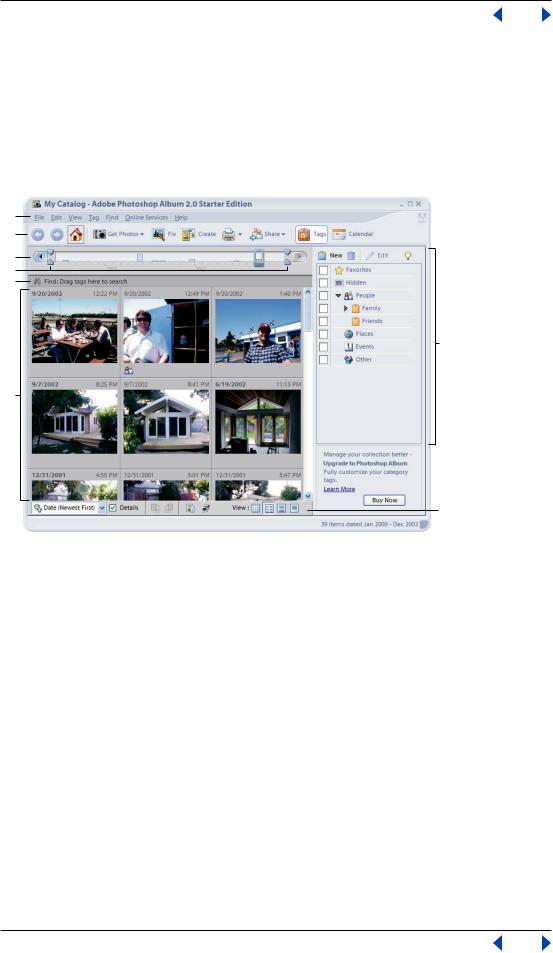
Adobe Photoshop Album Help Addendum: Getting Started with Adobe Photoshop Album 2.0
Using Help | Contents | Index |
Back |
6 |
first order is convenient when you need to attach tags to the photos you imported most recently.
•Date (Oldest First) to show all the photos in chronological order.
•Import Batch to display photos in the batches in which they were imported. Each batch is separated by a bar that displays information about the way you got the photos.
•Folder Location to display photos by the folders in which they are stored.
A
B
C
D
E
G
F
H
The Photoshop Album work area
A. Menu bar B. Shortcuts bar C.Timeline D.Timeline endpoint markers E. Find bar F. Photo well G.Tag pane H. Options bar
Above the photo well is the timeline. It helps you view and find photos by date.The height of each bar in the timeline shows the number of photos in each month, import batch, or folder.You can select a range of photos to view by clicking a bar or dragging the endpoints of the timeline.
In the options bar just under the photo well are controls for viewing photos and their properties. Among the controls is a View Slideshow  button that instantly displays a slideshow of the photos you’ve selected in the photo well.
button that instantly displays a slideshow of the photos you’ve selected in the photo well.
For more details on the Photoshop Album work area, see the Photoshop Album 2.0 Help.
Using Help | Contents | Index |
Back |
6 |

Adobe Photoshop Album Help Addendum: Getting Started with Adobe Photoshop Album 2.0
Using Help | Contents | Index |
Back |
7 |
Organizing your photos
Photoshop Album 2.0 Starter Edition automatically organizes your photos in the photo well based on when they were taken. However, you can enhance the organization, sorting, previewing, and finding of photos by using tags.You can use keyword tags to find photos based on the people in them, where the photo was taken, the event, and other characteristics of the photo that are important to you.When you tag your photos, you don’t have to remember each photo’s filename, date, or folder. Using tags also liberates you from filing your photos in folders by subject, and from renaming your photos and videos.
To use tags, you first need to open the Tag pane. Attach one or more tags from the Tag pane to a photo in the photo well by dragging and dropping them onto the photo.Tags don’t change the photos they are attached to; they simply give you additional and more flexible ways of finding and organizing your photos.
To open the Tag pane:
Click the Tags button  in the shortcuts bar.
in the shortcuts bar.
To create your own tag:
1Click the New button  in the Tag pane and choose New Tag.
in the Tag pane and choose New Tag.
2In the Create Tag dialog box, use the Category menu to choose which category or subcategory you want to list the tag under.
3In the Name text box, type the name you want to give the tag.
4In the Note text box, type any information you want to add about the tag. (For example, you could write that Mildred is your mom’s elementary school friend who lives in New York.)
5Click OK.
The tag appears in the Tag pane under the category or subcategory you selected.
Notice that the tag has a question mark icon  .The first time you attach the tag to a photo, it will use that photo as its icon.You can change the icon to a different photo. For more information on changing the icon and for using tags, see the Photoshop Album 2.0 Help.
.The first time you attach the tag to a photo, it will use that photo as its icon.You can change the icon to a different photo. For more information on changing the icon and for using tags, see the Photoshop Album 2.0 Help.
To attach a tag to a photo:
Drag the tag from the Tag pane onto the photo in the photo well.
Finding your photos
It’s easy to find photos in Photoshop Album 2.0 Starter Edition.You can use tags to find photos by subject. In the Tag pane, double-click a specific tag; the search will find all photos that have that particular tag attached. Simply select the check boxes next to the tags and you will be able to cross-reference or search using multiple tags.The Best match results will find photos that have all the selected tags in them.The Close match results will find photos that have one or more of the selected tags in them.
The timeline lets you narrow the range of photos and jump to a particular month just by clicking a bar.
Using Help | Contents | Index |
Back |
7 |
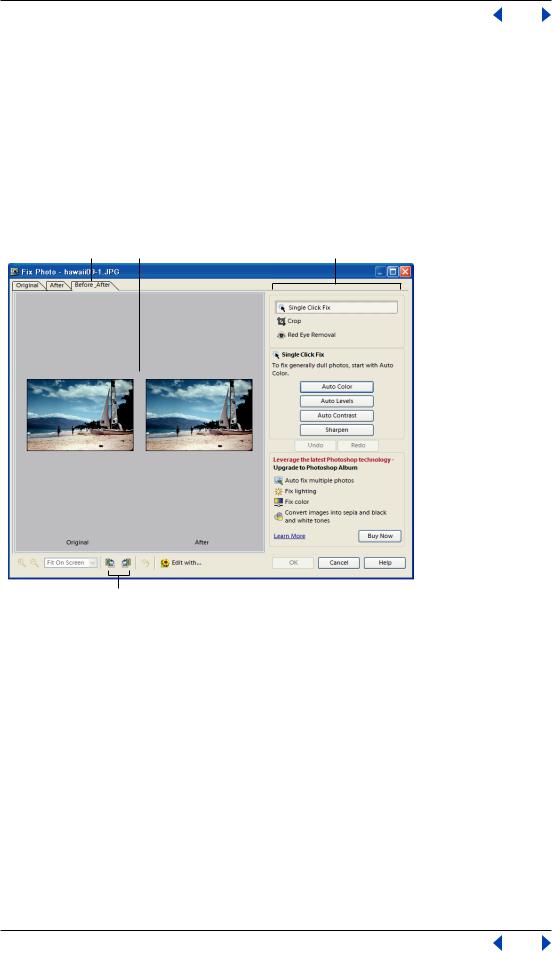
Adobe Photoshop Album Help Addendum: Getting Started with Adobe Photoshop Album 2.0
Using Help | Contents | Index |
Back |
8 |
For more information and procedures on finding photos using timeline or tags, see the Photoshop Album 2.0 Help.
Fixing photos
The photos you bring into Photoshop Album 2.0 Starter Edition may not be perfect. Photoshop Album 2.0 Starter Edition provides tools to fix the most common photo problems. For instance, you can apply a quick fix to adjust the overall color, brightness, contrast, or sharpness of the photo.You can also rotate or crop a photo or remove red-eye from it.
A B C
D
The Fix Photo dialog box
A.Tabs for choosing different views of the photo B. Preview images C. Editing options D. Rotate options
To fix photos in Photoshop Album 2.0 Starter Edition:
1Select a photo in the photo well and click the Fix button  in the shortcuts bar. Photoshop Album 2.0 Starter Edition makes a copy of the original photo file for editing.
in the shortcuts bar. Photoshop Album 2.0 Starter Edition makes a copy of the original photo file for editing.
2In the Fix Photo dialog box, choose one of the following:
Single Click Fix Applies an automatic correction for color, contrast, or sharpening.
Crop Lets you crop a photo to improve the composition or add emphasis to an image.
Red Eye Removal Corrects for the red-eye effect caused by a camera flash.
For details on fixing photos and the advanced options for fixing photos in Photoshop Album 2.0, see the Photoshop Album 2.0 Help.
Using Help | Contents | Index |
Back |
8 |

Adobe Photoshop Album Help Addendum: Getting Started with Adobe Photoshop Album 2.0
Using Help | Contents | Index |
Back |
9 |
Creating a PDF slideshow
PDF slideshows automatically present your photos in the sequence you specify. Slideshows are a good way to share your photos via e-mail and view them on a computer screen.
PDF is a universal file format that can be read by anyone who has the free Adobe Reader software. PDF provides a better photo-viewing experience for your recipients
by packaging up all the individual photos into a slideshow, complete with transitions.Your recipients can download the free Adobe Reader from the Adobe Web site (http:// www.adobe.com).
To create a PDF slideshow:
1In the photo well, select the photos you want to use in the slideshow. If you don’t make a selection, all the photos in the photo well will be used in the slideshow.
2Click the Create button  in the shortcuts bar.
in the shortcuts bar.
3In the Create Slideshow dialog box, click the Add Photos button to add any more photos to the slideshow you are about to create.
4In the Add Photos to Creation dialog box, display a set of photos by clicking one of the options at the left.
5Select the photos you want to include in your creation by clicking the check box next to each one.
6Click Add to Creation.The photos you selected are added to your PDF slideshow, and the check boxes are cleared to let you make a new selection. When you’re done adding photos, click OK.
7In the Create Slideshow dialog box, rearrange, duplicate, or remove photos as desired. Click the Full Screen Preview button  to preview your slideshow.
to preview your slideshow.
8Click OK and follow the on-screen instruction to save your PDF slideshow.
Sharing and printing your photos
Photoshop Album 2.0 Starter Edition lets you share your photos by e-mailing, printing them locally, ordering prints online, and sharing online.You can e-mail individual photos or a PDF slideshow. When you print, you can make individual prints, contact sheets or a Picture Package.You can also order prints via the Web using the Online Services feature.
To e-mail photos:
1Select one or more photos in the photo well.
2Click the Share button  in the shortcuts bar, and then choose E-mail from the pop-up menu. Follow the on-screen instructions to choose recipients and specify a format for the attachment.
in the shortcuts bar, and then choose E-mail from the pop-up menu. Follow the on-screen instructions to choose recipients and specify a format for the attachment.
Photoshop Album 2.0 Starter Edition automatically resizes and compresses your photos for a smoother e-mail delivery.You can also package up multiple photos into a slideshow by clicking the PDF Slideshow button in the E-mail window. Photoshop Album 2.0 Starter Edition generates the attachment and then launches your default e-mail program.To get more information on setting your e-mail preferences, see the Photoshop Album 2.0 Help.
Using Help | Contents | Index |
Back |
9 |

Adobe Photoshop Album Help Addendum: Getting Started with Adobe Photoshop Album 2.0
Using Help | Contents | Index |
Back |
10 |
To print photos to your printer
1Make sure that your printer is on and connected to your computer.
2In the photo well, select one or more photos that you want to print.
3Click the Print button  in the shortcuts bar and choose Print from the pop-up menu.
in the shortcuts bar and choose Print from the pop-up menu.
4Select options in the Print Photos dialog box and click Print. For more details on printing photos, see the Photoshop Album 2.0 Help.
A B C
Three different printing options
A. Individual prints B. Contact sheet C. Picture package
To print photos from an online service:
First select the photo or photos you want to order. Click the Print button  and choose Order Prints from the pop-up menu. Follow the on-screen instructions to finish ordering your prints.The service list may be updated each time you select the Online Services command, so check it occasionally for new services.
and choose Order Prints from the pop-up menu. Follow the on-screen instructions to finish ordering your prints.The service list may be updated each time you select the Online Services command, so check it occasionally for new services.
To share photos online:
1Select the photo or photos you want to share.
2Do one of the following:
•Click the Share button  in the shortcuts bar, and then choose Share Online from the pop-up menu.
in the shortcuts bar, and then choose Share Online from the pop-up menu.
•Choose Online Services > Share Services, and then choose a service from the list.
3The first time you use a provider, an End User License Agreement appears. Click the Agree button to continue.
4A screen appears to let you know that you’ve left the Adobe Photoshop Album program. From this point, if you need help, refer to the service provider’s customer service or help system.
To download shared photos:
1Choose Online Services > Download, and then choose a service from the list.
2The first time you use a provider, an End User License Agreement appears. Click the Agree button to continue.
3A screen appears to let you know that you’ve left the Adobe Photoshop Album program. From this point, if you need help, refer to the service provider’s customer service or help system.
Using Help | Contents | Index |
Back |
10 |

Adobe Photoshop Album Help Addendum: Getting Started with Adobe Photoshop Album 2.0
Using Help | Contents | Index |
Back |
11 |
For more details on sharing your photos through prints, e-mail, or online services, see the Photoshop Album 2.0 Help.
Using Help | Contents | Index |
Back |
11 |
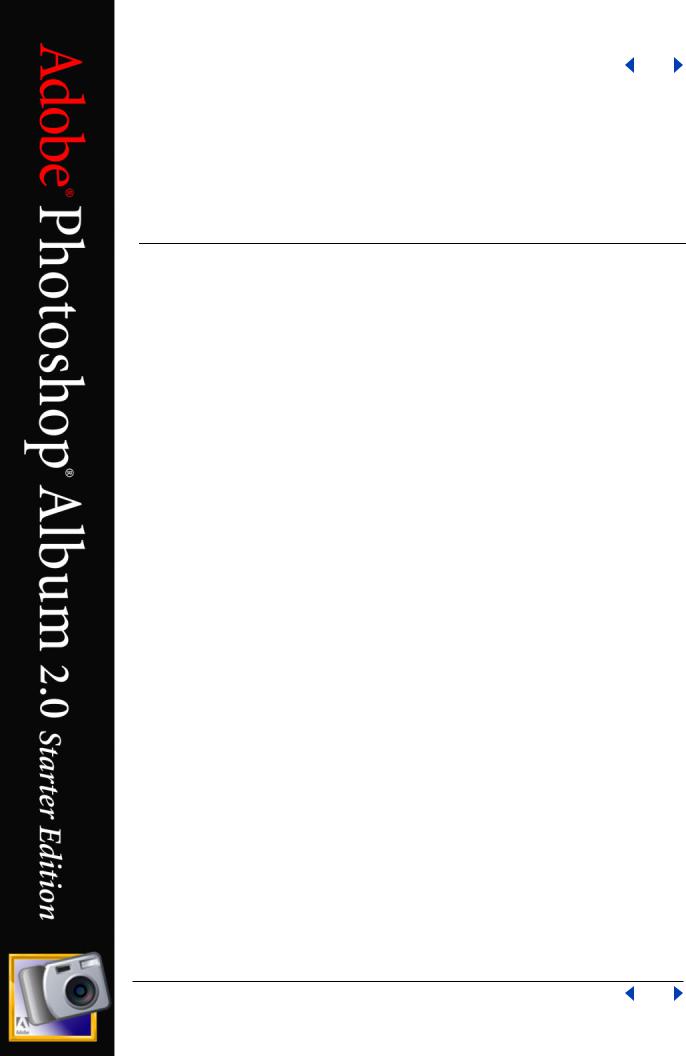
Adobe Photoshop Album Help |
Installing and Learning to Use Adobe Photoshop Album |
|
|
|
|
Using Help | Contents | Index |
Back |
12 |
Installing and Learning to Use Adobe Photoshop Album
Introduction
Welcome to the Adobe® Photoshop® Album application, the fast and easy way to organize your lifetime of photos so that you can instantly find the ones you want and share your experiences with anyone, anywhere. Photoshop Album has features designed specifically for active picture takers, photo-hobbyists, and business users who want to organize their digital photos, create albums, print photos, e-mail photos, share photos on the Web, or make a CD or disc for viewing on a computer or TV screen.
Registration
Please register your copy of the application so Adobe can continue to provide you with the highest quality software, offer technical support, and inform you about new Photoshop Album software developments.
When you first start the Adobe Photoshop Album application, you’re prompted to register online.You can choose to submit the form directly or fax a printed copy.You can also register by filling out and returning the registration card included with your software package.
Installing Adobe Photoshop Album
You must install the Photoshop Album application from the Adobe Photoshop Album CD onto your hard drive; you cannot run the application from the CD.
Follow the on-screen installation instructions. For more detailed information, see the How to Install Read Me file on the CD.
Tools for using Adobe Photoshop Album
Adobe provides a variety of options to help you learn and use Photoshop Album, including built-in Help, the Photoshop Album Quick Guide, context-sensitive menus, and tool tips.
In addition to this Getting Started Guide, you’ll also find Adobe Portable Document Format (PDF) documents on the Photoshop Album CD.The Adobe Acrobat® Reader® lets you view PDF documents and is included on the CD as part of the Photoshop Album installation.
Using Help | Contents | Index |
Back |
12 |

Adobe Photoshop Album Help |
Installing and Learning to Use Adobe Photoshop Album |
|
|
|
|
Using Help | Contents | Index |
Back |
13 |
Using Help
Adobe Photoshop Album includes complete documentation in an easily accessible, built-in Help system.The Help system contains essential information on using all Photoshop Album commands, features, and tools, as well as keyboard shortcuts and full-color illustrations.
When launched, the Help system is displayed in a Web browser for easy navigation.To properly view the Help topics, your computer must have either Netscape Communicator (4.75 or higher) or Microsoft® Internet Explorer (5.0 or higher) installed.
To start Photoshop Album Help:
Do one of the following:
•Press the F1 key.
•Choose Help > Adobe Photoshop Album Help from the menu bar.
•Click the Help button  located in the lower right corner of the Quick Guide window.
located in the lower right corner of the Quick Guide window.
Using the Photoshop Album Quick Guide
By default, the Photoshop Album Quick Guide window opens when the application is launched.The Quick Guide is a convenient starting point for major tasks in Photoshop Album. For more information on using the Photoshop Album Quick Guide, see “Start using Photoshop Album” on page 17.
Using context-sensitive menus
Photoshop Album streamlines your use of the application with context-sensitive menus. These menus display options for photos and tools, and change depending on the item that’s currently selected.
A context-sensitive menu
To display context menus:
1Position the pointer over an image or item in a pane.
2Right-click.
If no context-sensitive menu appears, no menu is available for that tool or pane.
Using Help | Contents | Index |
Back |
13 |

Adobe Photoshop Album Help |
Installing and Learning to Use Adobe Photoshop Album |
|
|
|
|
Using Help | Contents | Index |
Back |
14 |
Using tool tips
The tool tips feature displays the name or function of tools, buttons, or controls.
A tool tip
To identify a tool, button, or control:
Position the pointer over a tool, button, or control, and pause. A tool tip appears showing the name or function and sometimes the keyboard shortcut for the item.
Note: Tool tips are not available in most dialog boxes. However, some dialog boxes contain hyperlinks that display explanations or tips.
Using Web resources
If you have an Internet connection, you can access additional resources for learning Photoshop Album on the Adobe Systems Web site.These resources are continually updated.
To access the Adobe home page for your region:
Do one of the following:
•Click the Go to Adobe.com button  near the top-right corner of the application window.
near the top-right corner of the application window.
•Choose Help > Adobe Online from the menu bar.
Customer support
When you register your product, you may be entitled to technical support for a single incident.Terms vary depending on your country of residence and are available only for retail versions. For more information, refer to the registration card provided with your Photoshop Album documentation.
Additional customer support resources
Adobe Systems also provides several forms of automated technical support:
•See the ReadMe and ReadMe First! files installed with the program for information that became available after this guide went to press.
•Choose Help > Support to explore the extensive customer support information on Adobe’s Web site.
Using Help | Contents | Index |
Back |
14 |

Adobe Photoshop Album Help |
Photoshop Album Basics |
|
|
|
|
Using Help | Contents | Index |
Back |
15 |
Photoshop Album Basics
Enjoying your photo collection with Photoshop Album
If you love to take pictures, you’ve probably accumulated piles of shoeboxes filled with prints and negatives. Or maybe you’ve gone digital and you’re trying to keep track of all those photo files on your computer. Now you can spend time enjoying your photos instead of just looking for them. Let Adobe Photoshop Album be the hub to manage your lifetime of photos. With Photoshop Album, you can bring photos into your computer, organize them, find them, view them, fix them, get creative with them, and share them.
With Photoshop Album, you see all your photos in one place, organized by the time you took the photos, even if they’re spread across many folders on your computer. Gone is the tedium of painstakingly organizing your folders by subject or renaming all your photo files—only to discover that you still have no way to see a list of all your photos by date and time or that you put a photo in one folder but went looking for it in another.
Get photos from various devices such as digital cameras, scanners, and folders on your computer and bring them into Photoshop Album.You can also bring video clips or audio clips into Photoshop Album. Once photos and media are in Photoshop Album, you can organize, view, and find them.You can even fix common photo problems. As the hub for all your photo activities, Photoshop Album lets you make such creations as albums, greeting cards, slideshows, and Web photo galleries based on your photos.You can also share your photos online or in print, all without leaving the program.
Using Help | Contents | Index |
Back |
15 |

Adobe Photoshop Album Help |
Photoshop Album Basics |
|
|
|
|
Using Help | Contents | Index |
Back |
16 |
Photoshop Album recognizes digital photos, video, and audio in some of the most commonly used formats. For more information on file formats you can bring into Photoshop Album, see “Working with different file formats in Photoshop Album” on page 39.
|
GET PHOTOS |
|
BURN AND |
ORGANIZE |
|
BACKUP |
||
|
||
|
ADOBE |
|
|
PHOTOSHOP ALBUM |
|
SHARE |
FIND |
CREATE |
FIX |
Adobe Photoshop Album is the hub of all your work with photos—the fast and easy way to organize and share your lifetime of photos.
How Photoshop Album works
Adobe Photoshop Album creates links to your photos so it knows where the photo is located, what file format it’s in, and so forth. Photoshop Album does this by keeping information about your photos, video clips, and audio clips in a database of information called the catalog.
Photoshop Album automatically creates a catalog for you named My Catalog.psa when you first launch the application and bring in photos.Your catalog keeps track of the photos, video clips, and audio clips on your computer and on other media such as discs. It’s a collection of information about each photo, but it doesn’t contain the actual photos themselves.
Photos, video clips, and audio clips brought into Photoshop Album are automatically organized by the date/time the photo was taken by the digital camera. For more information about how Photoshop Album automatically organizes your photos in the timeline, see “The timeline” on page 20 and “Organizing photos in the photo well” on page 43.
Using Help | Contents | Index |
Back |
16 |

Adobe Photoshop Album Help |
Photoshop Album Basics |
|
|
|
|
Using Help | Contents | Index |
Back |
17 |
Photoshop Album also has a powerful tags feature that functions much like attaching keywords to identify your photos. It’s very similar in concept to the use of name tags or luggage tags.Tags give you even more flexibility in how you manage, identify, and organize photos by letting you find photos based on the people in them, where the photo was taken, what the event was, and so forth.You can have multiple tags for any photo to mark the photo with all of the things that are important about it. By selecting any combination of tags, you can find and organize just the photos you want. For more information on tags, see “The Tags pane” on page 23 and “Organizing photos into catalogs” on
page 71.
Of course, if you want the tags to reflect your existing folder organization, Photoshop Album gives you an easy way to create and apply tags based on those folder names. For more information, see “Creating and attaching tags based on existing folder names” on page 55.
Start using Photoshop Album
When you first start Photoshop Album, the Quick Guide window is open by default. The Quick Guide is a convenient “jumping off” point to all the major tasks in Photoshop
Album. Select a task by clicking an icon in the Quick Guide Overview window or clicking a tab. If you’re a new user of Photoshop Album, your first task will be to get photos into Photoshop Album.
The Quick Guide can be closed or reopened at any time while you’re using Photoshop Album. For more information about a specific feature in the Quick Guide, see documentation on that feature in Photoshop Album Help.
To start Photoshop Album:
1 Do one of the following:
•Double-click the Photoshop Album icon  on your desktop.
on your desktop.
•Use the Start menu to find and open Photoshop Album.
Using Help | Contents | Index |
Back |
17 |

Adobe Photoshop Album Help |
Photoshop Album Basics |
|
|
|
|
Using Help | Contents | Index |
Back |
18 |
By default, the Quick Guide window appears on top of the Photoshop Album work area.
The Quick Guide Overview window
2 In the Quick Guide Overview window, do one of the following to start using Photoshop Album immediately:
•Click a tab.
•Click one of the six icons in the Overview window.
Note: Click the Help button  at the bottom-right corner of the Quick Guide window if you want to access the built-in Help. For more information on Help, see “Using Help” on
at the bottom-right corner of the Quick Guide window if you want to access the built-in Help. For more information on Help, see “Using Help” on
page 13.
To open the Quick Guide (if it’s been closed):
Choose Help > Quick Guide from the menu bar.
To automatically show the Quick Guide when you start Photoshop Album:
1Choose Edit > Preferences, and then click General from the list on the left.
2Select Show Quick Guide at Startup.
Using Help | Contents | Index |
Back |
18 |
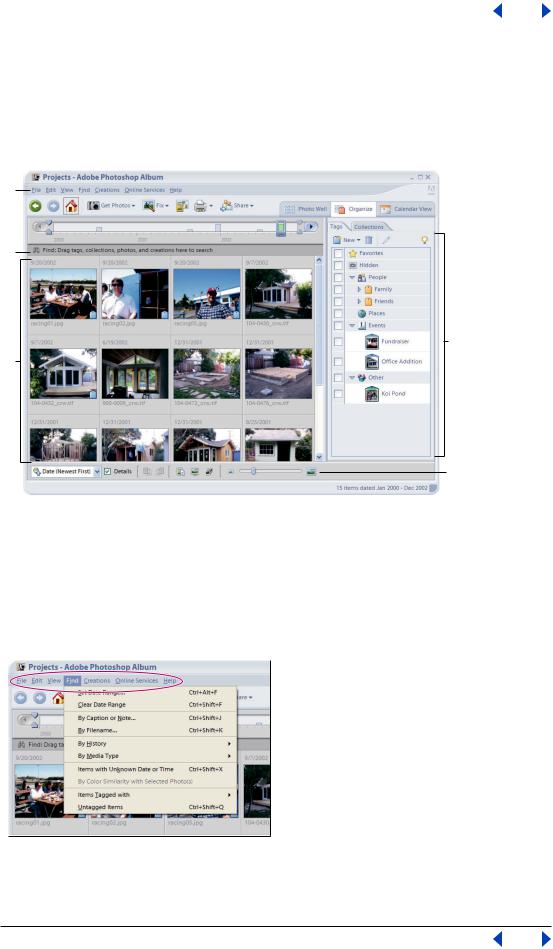
Adobe Photoshop Album Help |
Photoshop Album Basics |
|
|
|
|
Using Help | Contents | Index |
Back |
19 |
About the Photoshop Album work area
The Adobe Photoshop Album work area is designed to help you get, find, view, organize, and fix photos; make creations; and share those photos and creations.To do all this, the work area is organized into several related components that help you move from one task to another easily and effectively.
A
B 
 F C
F C 
 G
G
D
H
E
I
The Photoshop Album work area
A. Menu bar B. Shortcuts bar C.Timeline D. Find bar E. Photo well F. Calendar view G. Collections tab for displaying Collections pane H.Tags pane I. Options bar
The menu bar
The menu bar contains commands for performing tasks.The menus in the menu bar are organized according to the type of task you can perform. For example, the Find menu lists commands for finding photos according to date, name, and so forth.
The menu bar
Using Help | Contents | Index |
Back |
19 |
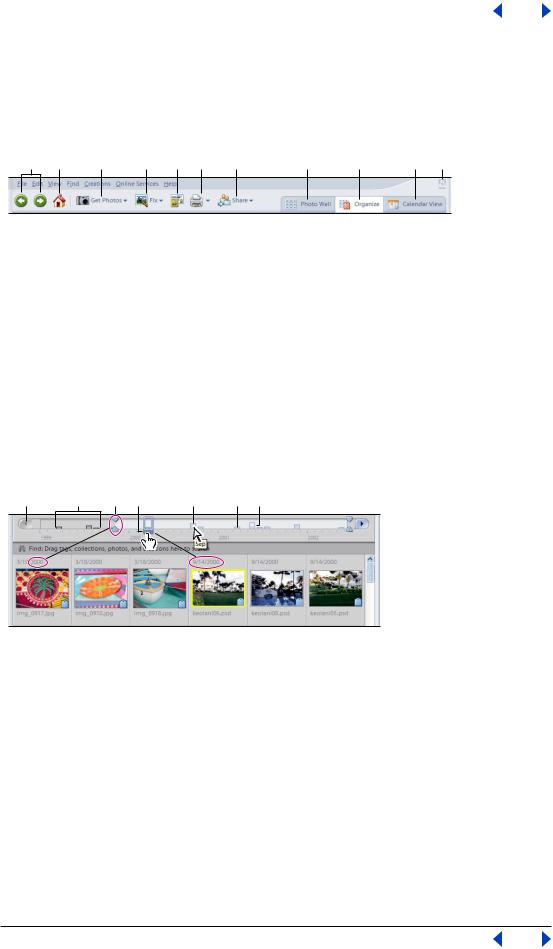
Adobe Photoshop Album Help |
Photoshop Album Basics |
|
|
|
|
Using Help | Contents | Index |
Back |
20 |
The shortcuts bar
The shortcuts bar displays buttons for common commands, and is located just below the menu bar.You can quickly click these commands as you need them while you’re working in Photoshop Album.To see the name of a button, position the pointer over the button and its tool tip appears.
A B C D E F G H I J K
The shortcuts bar
A. Navigation buttons B. Click to show all photos C. Get photos, video, and audio D. Fix photos E. Start a new creation F. Print photos G. E-mail and share photos H. Display items in the photo well I. Display the Tags pane and Collections pane J. Display items in the calendar view K. Go to Adobe.com
The timeline
The timeline lets you find photos by the date they were taken. When you select a date or range of time in the timeline, photos that were created or saved with that date appear in the photo well. When you select a range of time in the timeline, the photo well scrolls to the photos that were taken within that range.You can also scroll to a particular month in any year by clicking that month in the timeline.The timeline also shows how items are distributed across time; the height of each bar is proportional to the number of images in each month.
For more information on the timeline, see “Using the timeline to find photos” on page 82.
A B C D E F G
Using the timeline
A.Click to scroll the range of the timeline B.Gray area indicates photos out of set range C.Drag end points to refine searches D. Click a bar or drag the marker to scroll to a different month E. Hold pointer over a bar to identify its range (month, import batch date, or file location) F.The height of the bar indicates the number of photos G. Blank area indicates hidden photos
The find bar
The find bar performs quick searches when you drag tags onto it.When not in use, the find bar is a horizontal bar right above the photo well.When you drag a tag onto it, the find bar automatically expands so you can see the tags you’ve added to the search. Every file with the chosen tag attached to it will be found, so if you want to refine your search, you can drag more tags onto the find bar.
Using Help | Contents | Index |
Back |
20 |
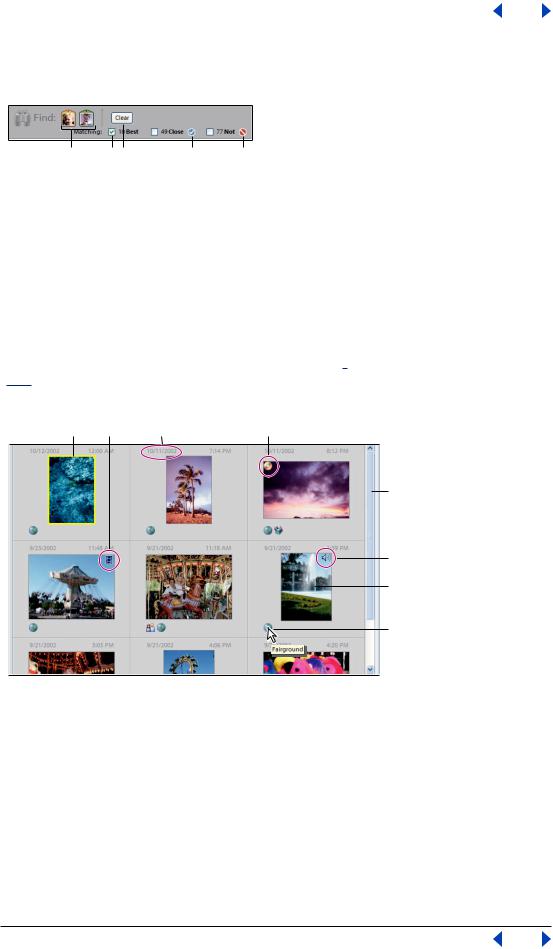
Adobe Photoshop Album Help |
Photoshop Album Basics |
|
|
|
|
Using Help | Contents | Index |
Back |
21 |
In addition, when you drag a creation or collection onto the find bar, the photos in it are displayed in the photo well, replacing any previous view.
A B C D E
Find bar expanded with search criteria
A. Search criteria B. Click a check box to show search results C. Clear the search and close the find bar D. Close match E. Not matching
The photo well
The photo well is the area where your photos, video clips, audio files, and creations are displayed, either one at a time or in a grid of thumbnails.The options bar located below the photo well contains a row of buttons that provide quick access to the most common actions for changing the view options of the photo well, including a photo well arrangement menu that specifies the sort order for displaying the photos. In the photo well, you can select the items you want to do things with, such as attach tags to photos and add photos to creations. For more information, see “Viewing photos in the photo well” on page 79.
To view the photo well, click the Photo Well button  in the shortcuts bar.
in the shortcuts bar.
A B C D
E
F
G
H
The photo well in medium thumbnail view with the Details option selected
A. Selected image B. Indicates video clip C. Click to edit date and time D. Indicates offline photo E. Scroll to view photos F. Indicates audio caption attached G. Double-click to view as Single Photo H. In the medium thumbnail view, place the pointer over the icon to see tag names
The calendar view
The calendar view lets you display and find items by day, month, or year. When the calendar view is displayed, it shows the first photo for each day, and it identifies the number of photos (or video clips) taken on that day. In the calendar view, you can do many of the same operations on photos that you can do from the photo well.You can even keep track of recurring events, such as holidays and birthdays, and add notes to any day in the calendar view. For more information, see “Using the calendar view” on page 83.
Using Help | Contents | Index |
Back |
21 |
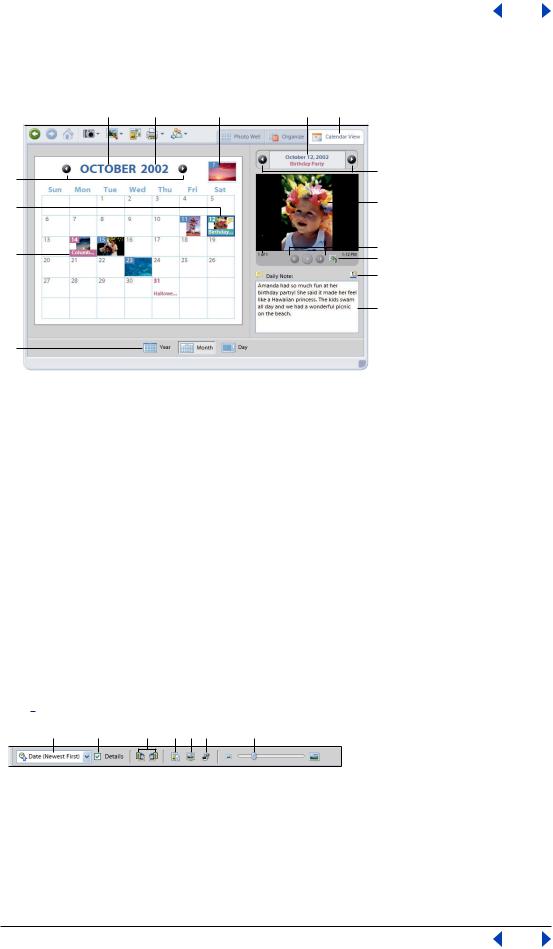
Adobe Photoshop Album Help |
Photoshop Album Basics |
|
|
|
|
Using Help | Contents | Index |
Back |
22 |
To view the calendar view, simply click the Calendar View button  in the shortcuts bar.To switch to the photo well, click the Photo Well button
in the shortcuts bar.To switch to the photo well, click the Photo Well button  in the shortcuts bar.
in the shortcuts bar.
A B C D E
K
F
L
G
H 
 M
M
N
I
O
P
Q
J
Using the calendar view
A. Click to select a month B. Click to select a year C. Click to view photos with unknown dates D. Click to select a date E. Click to display calendar view F. Click to view previous/next month G. Custom event H. Date currently selected I. Holiday J. Click to choose Year, Month, or Day view K. Click to view previous/next day
L. Right-click photo to display commands M. Number of photos for selected date N. Controls for viewing slideshow O. Click to display item in photo well P. Add an event Q. Enter a daily note
The options bar
The buttons in the options bar help you organize and sort files in the photo well and calendar view.You can display information on what each button on the options bar does by holding the mouse pointer over that button.
For the photo well, the options bar lets you choose the order by which to display items, show detailed information about each item, rotate photos, display the Properties palette, view photos as a slideshow, and specify the size of thumbnails.
For the calendar view, the options bar lets you select whether to view items by year, month, or day.
For more information on using the options bar for viewing photos in the work area, see “Viewing photos in the photo well” on page 79.
A B C D E F G
The photo well options bar
A. Photo well arrangement menu B. Show Details option C. Rotate left button D. Rotate right button E. Show/Hide Properties button F. Display Full Screen Preview button G.View Slideshow button H.Thumbnail view controls
Using Help | Contents | Index |
Back |
22 |

Adobe Photoshop Album Help |
Photoshop Album Basics |
|
|
|
|
Using Help | Contents | Index |
Back |
23 |
The Tags pane
Photoshop Album automatically organizes your photos in the photo well. However, you can enhance your photo organization by attaching keyword tags to them.Tags are a powerful tool for finding and identifying photos, video clips, audio clips, and creations so you don’t have to remember each item’s filename, date, or folder. Using tags also liberates you from having to file your items in folders by subject, and renaming them. For more information on using tags to organize photos, see “Using tags to organize your photos” on page 45.
To view the Tags pane, click the Organize button  in the shortcuts bar, and then click the Tags tab below it.
in the shortcuts bar, and then click the Tags tab below it.
A B C D
E
F
G
H
I
J
K
L
M
The Tags pane
A.Tags tab B. Delete button C. Edit button D. Show tag tips E. New button F. Favorites tag G. Hidden tag H. Category I. Subcategory J. User-created tag K. Selected tag L. Find check box M. Click to display the tags in that category or subcategory
The collections pane
A collection is a container that you put photos into. Using the photo well, you can then organize and display the photos in that collection in a custom order. (This is unlike tags, in which selecting a tag displays the photos associated with that tag either by date, import batch, or folder location.) Collections don’t change the photos in them; they simply give you additional and more flexible ways of finding and organizing your photos. You use the Collections pane to create, select, and modify collection containers. For more information on using collections to organize photos, see “Using collections to organize your photos” on page 57.
To view the Collections pane, click the Organize button  in the shortcuts bar, and then click the Collections tab below it.
in the shortcuts bar, and then click the Collections tab below it.
Using Help | Contents | Index |
Back |
23 |
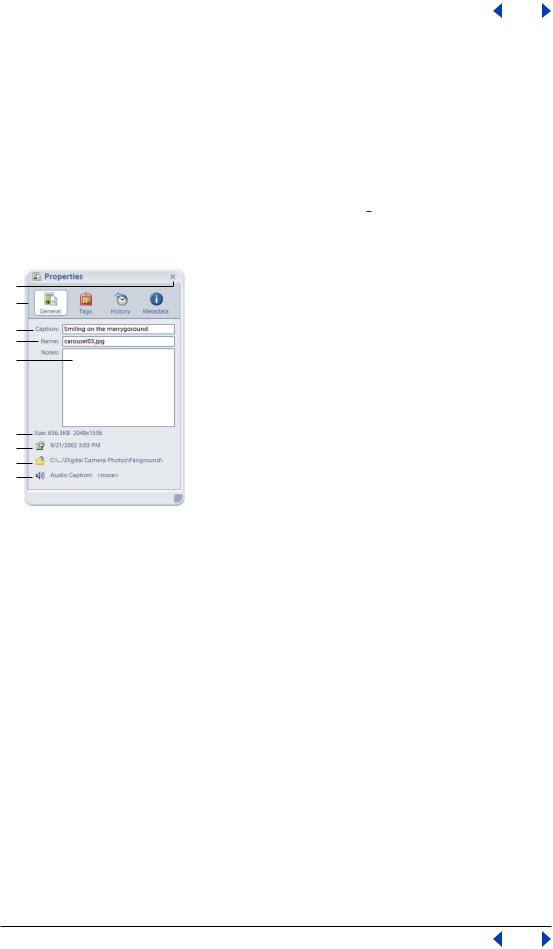
Adobe Photoshop Album Help |
Photoshop Album Basics |
|
|
|
|
Using Help | Contents | Index |
Back |
24 |
The Properties palette
The Properties palette contains detailed information about a selected photo or media file. In the Properties palette, you can view the name of the file, any captions or notes you’ve added to the file, metadata in the file, the dates you imported or modified the file, any creations using the file, any tags attached to the file, any collections the file is in, and the location (path) of the file on your computer.You can also record or listen to audio annotations attached to photos. Additionally, the Properties pane lets you rename a file, add a caption or notes, and adjust the date and time of the photo file. For more information on how to view or add information in the Properties pane, see “Viewing information about a photo” on page 66.
To view the Properties pane, click the Show or Hide Properties button  in the options bar.
in the options bar.
A
B
C
D
E
F
G
H
I
The Properties palette
A. Closes the Properties palette B. Buttons for choosing what information to view C. Caption of the photo, video clip, or audio clip D. Filename E.Type or view notes F. File size, dimensions (photos and video only), and playing time (audio only) G. Change the Date and Time H. Path to the file location on your computer I. Record, play, or attach the audio caption
Using Help | Contents | Index |
Back |
24 |

Adobe Photoshop Album Help |
Getting Photos into Photoshop Album |
|
|
|
|
Using Help | Contents | Index |
Back |
25 |
Getting Photos into Photoshop Album
Getting photos from digital cameras or card readers
The way you get your photos from a digital camera depends on how your camera attaches to your computer. Some cameras come with TWAIN drivers (software made by the manufacturer that allows the camera to communicate with your computer) that must be installed first. Photoshop Album uses these drivers to get photos from your camera to your computer.
Other cameras support WIA (Windows Image Acquisition) drivers which make the process of getting your photos as simple as connecting the camera to your computer and then clicking a button in Photoshop Album. WIA can be used only if you are running Windows XP or Windows Me.
Some cameras mount to your computer so that when the camera is connected it
 looks like an additional hard-disk drive on your computer.To get your photos from a mounted camera, follow the directions in “Getting photos from your computer” on
looks like an additional hard-disk drive on your computer.To get your photos from a mounted camera, follow the directions in “Getting photos from your computer” on
page 32.
If you have a flash card or memory card reader attached to your computer, or if you have a flash or memory card in your digital camera, Photoshop Album makes it easy to get your photos.You may also get your photos from a card reader using the directions in “Getting photos from your computer” on page 32.
Sometimes you may try to get photos that already exist in your catalog. If this happens, Photoshop Album displays a dialog box letting you know which photos you already have. These photos won’t be reimported.
Note: When you get photos from your camera using TWAIN drivers, you might lose some metadata, such as the date and time when the photo was taken. In addition, TWAIN drivers might convert files in JPEG format to TIFF format, using more disk space and slowing down the importing process. If your camera uses TWAIN drivers, consider using a card reader to get the photos instead of getting them directly from the camera.
Getting your photos from a digital camera or a card reader
Carefully read any documentation that came with your camera or card reader to make sure it’s connected correctly. If you’re using a camera with TWAIN drivers, make sure that you have installed the drivers that came with your digital camera before you launch Photoshop Album.
To get photos from a digital camera or card reader:
1Make sure that your camera or card reader is connected properly and turned on.
2Do one of the following:
Using Help | Contents | Index |
Back |
25 |

Adobe Photoshop Album Help |
Getting Photos into Photoshop Album |
|
|
|
|
Using Help | Contents | Index |
Back |
26 |
•Click the Get Photos button  in the shortcuts bar and then choose From Camera or Card Reader.
in the shortcuts bar and then choose From Camera or Card Reader.
•Choose File > Get Photos > From Camera or Card Reader.
If you have a WIA-enabled camera, Photoshop Album should automatically detect your camera when you attach it, so you won’t need to click the Get Photos button.
3 If the Get Photos from Camera or Card Reader dialog box appears, choose the name of the connected device from the Camera pop-up menu at the top of the dialog box.
Get Photos from Camera or Card Reader dialog box
4Next, select Create Subfolder Using Date/Time of Import if you want the photos you’re getting to be stored in their own folder, whose name includes the date and time they were imported. Click the OK button.
5Select Delete Photos on Camera or Memory Card after Import if you want to erase the photos from your camera once they’re brought into Photoshop Album.
6If you have a WIA-enabled camera, select the Import All Photos option if you want Photoshop Album to import all the images on your camera.
Note: If your camera uses TWAIN drivers, Photoshop Album may launch the driver that came with your digital camera. Acquire the photos from your camera as instructed by the driver software online help, or the printed documentation that came with your camera.
7 Click the OK button.
Important: If your camera does not appear as a choice in the menu, it could just mean that the camera is not connected or that the camera is not turned on.
You can rotate any photo you bring in from a digital camera. Select one or more photos you want to rotate.Then click the Rotate Left button  or the
or the
Rotate Right button  in the options bar.
in the options bar.
The photos you just imported are displayed in the photo well. For more information on navigating through the photo well, see “The photo well” on page 21.
Note: If the photos you import contain keyword metadata, the Import Attached Tags dialog box appears. For information on importing the keywords as tags, see “Importing tags attached to photos” on page 38.
Using Help | Contents | Index |
Back |
26 |

Adobe Photoshop Album Help |
Getting Photos into Photoshop Album |
|
|
|
|
Using Help | Contents | Index |
Back |
27 |
Setting camera or card reader preferences
Once you’ve set camera or card reader preferences, you may not have to change them unless you would like to get your photos from a different device.
If you have changed the settings and are having trouble getting your photos, try clicking the Restore Default Settings button to return the preferences to the original
configuration.The default settings work well for most users.
To set camera preferences:
1 If the Camera Preferences dialog box isn’t displayed on your screen, choose
Edit > Preferences to open the Preferences dialog box, and then choose Camera or Card Reader from the list on the left side of the dialog box.
Setting camera preferences
2 Choose the name of your camera from the Camera pop-up menu. If you’ve used more than one camera, each known camera will appear in the pop-up menu.
Note: Each time you connect with a different camera, you’ll need to select that camera from the list.
3If you want the photos you just downloaded to be cleared from your digital camera, select Delete Photos on Camera or Memory Card after Import (leave the option unchecked to keep the images on your camera).
4If you have a WIA-enabled camera, select Import All Photos if you want Photoshop Album to automatically get all the images on your digital camera. If you want to choose just some of the images, deselect this option.
5Make sure that Always Ask to Become Default Application is checked so that Photoshop Album launches when WIA-enabled cameras are attached to your computer. Even if you don’t have a WIA-enabled camera, it’s a good idea to keep this option selected.
6Under Files, select Create Subfolder Using Date/Time of Import if you want Photoshop Album to put imported photos in a new subfolder named according to the date and time you imported them.This is helpful if you need to locate the images on your computer. Also listed is the path to the main folder where your photos are stored.
 If you want to change the main folder location where imported files are stored, click
If you want to change the main folder location where imported files are stored, click  Files to display the Files page of the Preferences dialog box, and then choose a new location for saved files.That way, all imported files will be stored in a consistent location.
Files to display the Files page of the Preferences dialog box, and then choose a new location for saved files.That way, all imported files will be stored in a consistent location.
7 Click OK to close the Preferences dialog box.
Using Help | Contents | Index |
Back |
27 |

Adobe Photoshop Album Help |
Getting Photos into Photoshop Album |
|
|
|
|
Using Help | Contents | Index |
Back |
28 |
Getting photos from scanners
Photoshop Album lets you use a scanner to bring in images of your photos, negatives, and slides. Photoshop Album uses the scanner driver (software made by the manufacturer that allows the scanner to communicate with your computer) installed on your system to get scanned photos.The advantage of using these drivers is that you can usually choose the area of a photo you want to scan, and sometimes you can correct initial color problems, too. Other scanners use WIA (Windows Image Acquisition) drivers, which you can use if you are running Windows XP or Windows Me.
In Windows XP, you can set preferences that cause Photoshop Album to start as soon as your computer detects that your scanner is attached.This streamlines the impor-
tation process. See the documentation that came with your Windows XP operating system for more information.
Before you try to get your photos into Photoshop Album, make sure that you’ve installed all the software that came with your scanner. Carefully read any documentation that came with your scanner to make sure that it’s connected properly to your computer. If the Preferences dialog box displays on your screen after you click the Get Photos button, follow the directions in “Setting scanner preferences” on page 29 to set your scanner up.
If you’re having trouble getting your scanner to work well with Photoshop Album, you may want to use the software that came with your scanner instead. Simply scan
the photos as directed, and then save them to your computer.To bring them into Photoshop Album, follow the directions in “Getting photos from your computer” on page 32.
To get photos from scanners:
1 |
Make sure that your scanner is connected and turned on. |
2 |
Do one of the following: |
• |
Click the Get Photos button in the shortcuts bar, and then choose From Scanner from |
|
the pop-up menu. |
• Choose File > Get Photos > From Scanner. |
|
3 |
If the Get Photos from Scanner dialog box appears, choose the name of the scanner |
from the Scanner pop-up menu.
Get Photos from Scanner dialog box
Note: If you get a “None Detected” message in the Scanner menu, make sure that the scanner is on and properly connected to your computer.
Using Help | Contents | Index |
Back |
28 |

Adobe Photoshop Album Help |
Getting Photos into Photoshop Album |
|
|
|
|
Using Help | Contents | Index |
Back |
29 |
4 Choose a file format for the scanned photos from the Save As pop-up menu
(see “Working with different file formats in Photoshop Album” on page 39). JPEG is usually the best choice. Photoshop Album selects medium quality JPEG as the default format for your scan. If you choose the JPEG format, you’ll be able to drag the Quality slider. A higher quality setting results in a larger file but less data loss (see “Working with photo resolution” on page 144).
5Click the OK button.
6If you’re using a scanner with a TWAIN driver, Photoshop Album launches the driver that came with your scanner. Follow the instructions that came with the driver software to scan your photo.Typically, you can also select an area to scan, or correct any color issues that you may see.
Note: If you’re using Windows XP, then Photoshop Album launches the Windows XP scanning interface. Instructions can be found in Windows XP online help.
7 After the photo is scanned, Photoshop Album brings it in.You’ll see a preview of the scan in the Getting Photos dialog box.
After you get scanned images, you may want to change the date assigned to the photos (Photoshop Album assigns the import date to the photos, not the date they
were taken). For directions, see “Changing the date of a photo” on page 43.
Setting scanner preferences
Setting up your scanner is easy.The options provided by Photoshop Album help you work efficiently to get your scanned photos.
To set scanner preferences:
1 If the Scanner Preferences dialog box isn’t displayed on your screen, choose
Edit > Preferences to open the Preferences dialog box, and then choose Scanner from the Preferences list on the left side of the dialog box.
2 Choose the name of your scanner from the Scanner pop-up menu.
Note: Each time you connect with a different scanner, you’ll need to select that device from the list. The connected scanner is indicated to help you identify it.
3Choose a file format from the Save As pop-up menu. JPEG is the default format, and is the best choice for most users. For information on different file formats, see “Working with different file formats in Photoshop Album” on page 39.
4Under Files, select the folder where scanned photos are stored is listed. Click the Browse button to choose a new folder location. Also listed is the path to the main folder where your photos are stored.

 If you want to change the main folder location where imported files are stored, click
If you want to change the main folder location where imported files are stored, click  Files to display the Files page of the Preferences dialog box, and then choose a new location for saved files.That way, all imported files will be stored in a consistent location.
Files to display the Files page of the Preferences dialog box, and then choose a new location for saved files.That way, all imported files will be stored in a consistent location.
5 Click OK to close the Preferences dialog box.
Using Help | Contents | Index |
Back |
29 |
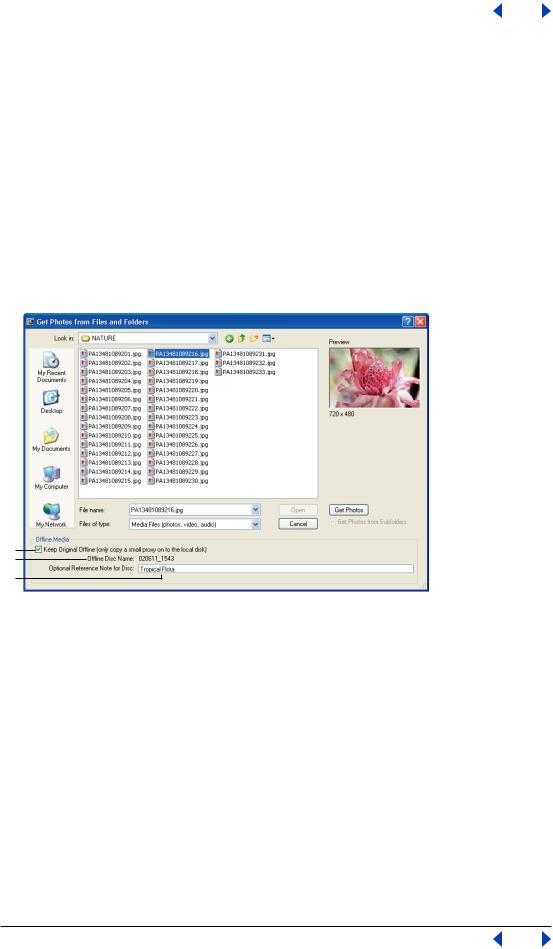
Adobe Photoshop Album Help |
Getting Photos into Photoshop Album |
|
|
|
|
Using Help | Contents | Index |
Back |
30 |
Getting photos from CDs and DVDs
When you get photos from CDs and DVDs, you can choose whether or not to bring the photos onto the hard disk drive of your computer, or leave them on the CD or DVD, known as keeping them offline. A low-resolution copy, or proxy file, of a master photo kept offline is shown in your catalog so you can continue to view the photo in Photoshop Album. When you perform an operation that requires the original photo, you will be asked to insert the disc on which the offline photo is stored.You can then decide to use the proxy file, bring in the master photo, or cancel the procedure.
When you choose to keep a master photo offline, Photoshop Album asks you to give the CD or DVD a reference name.The reference name you choose should be meaningful to you. It’s smart to write the reference name you’ve chosen on the CD or DVD or on the disc’s jewel case. When Photoshop Album requests the master disk, it will provide the reference name so you can insert the correct CD or DVD.
A
B
C
Getting photos from a CD or DVD
A. Choose to keep the master photo offline B. Name of the CD that your computer recognizes C. Add a reference name for the CD or DVD that is meaningful for you in the text box
To get photos from a CD-ROM or DVD:
1 Do one of the following:
•Click the Get Photos button  in the shortcuts bar, and then choose From Files and Folders from the pop-up menu.
in the shortcuts bar, and then choose From Files and Folders from the pop-up menu.
•Choose File > Get Photos > From Files and Folders.
2Navigate to your CD-ROM or DVD drive.
3Select the photos you want to import from the CD-ROM or DVD.
4Select Keep Original Offline to add just a copy of the photo to your Photoshop Album catalog. If this option is selected, a low-resolution copy (or proxy file) will be downloaded on your computer, and Photoshop Album will reference it from that location.To download the master photo, leave this option deselected.
Using Help | Contents | Index |
Back |
30 |
